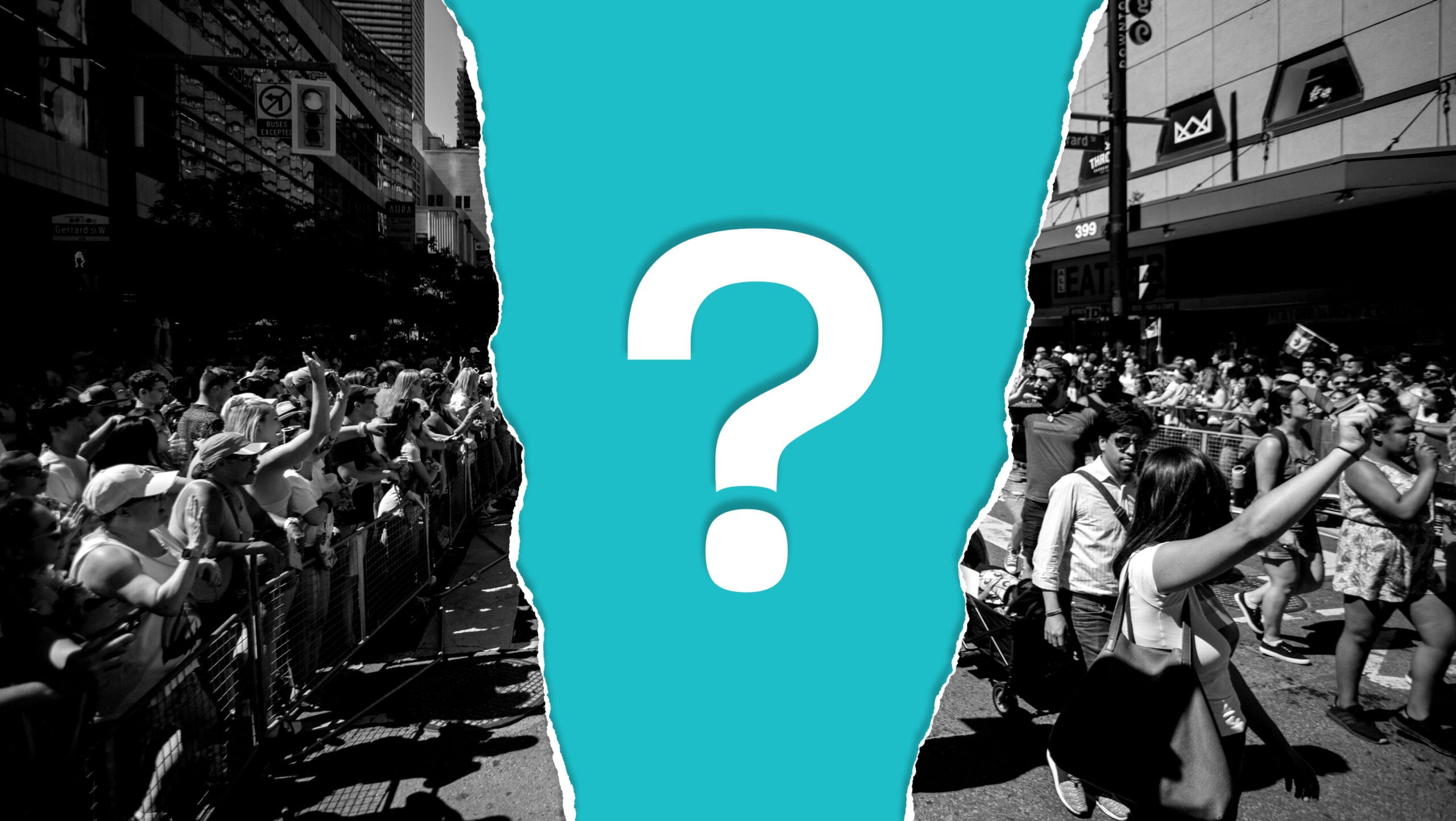I’m not exaggerating when I say that hundreds of thousands of people have cheered me on at Pride Day as I did the stupidest schtick wearing the crappiest tat. Prancing unicorn, dizzy cheerleader, Fellini beach lady… the list is as extensive as it is ridiculous.
Luckily, my boyfriend is as much a ham as I am. Each summer during our 18-years together, he and I have run through Toronto’s Pride Parade dressed in silly outfits. Though sometimes joined by friends, we’ve never been part of any officially-sanctioned group. We’ve never registered. We don’t ask for permission. We go guerilla style: Jumping in at some random point in the four- to five-hour-long parade, often dodging a volunteer or security person trying to corral us. We follow whatever float or contingent we want, joining and dancing with different groups for a while, then running ahead to find others to play with. When people complain about how boring the parade can be, I get it. I would never stand there crammed in among the hordes on the sidelines. Being in the parade is so much more exciting.
Once we dressed as school children from Alfred Hitchock’s The Birds. We wired battery-operated flapping birds to our backpacks so it looked like they were pecking at our heads. We ran through the entire parade screaming like banshees. Some people were horrified. But others got the high camp concept—it was a political theme: “The Birds of Oppression.” Another time we donned bonnets and babydoll nighties and dubbed ourselves the “Gaybies.” A lot of people were horrified by that one, too. (Toddlers, oddly, loved it.) Over time, we began to get recognized. The year we dressed as “Bubbles”—the two of us blowing soap bubbles in our underwear while wearing hats made from ping pong balls—we overheard two people discussing how “disappointing” our outfits were compared to previous efforts. Needless to say, we upped our game the following year when, as it happened, Toronto hosted World Pride. We went as “Co-Monarchs of the World,” anointing hundreds with our giant maces filled with glitter.
Of course, it’s not just about the outfits. We don’t just wave politely from some political party contingent or atop a corporate flatbed truck amidst go-go dancers (we don’t have abs). We work the crowd. We force people to respond. And respond they do.
Early on we learned how to exploit the parade’s supersized success: Invariably, big gaps open up between floats and marching groups. So those one million spectators who attend Toronto Pride annually are often standing around looking at blocks and blocks of empty pavement, waiting for something to happen. That something is me and my boyfriend, dancing into the void and yelling, among other slogans, our favourite standby: “Hooray for homosexuals!” The crowds go nuts. They really do; they roar. They’ve got nothing better to do, or see. Just two middle-aged queens in their underwear making fools of themselves.
There is a method to this madness: Our own little radical mission to take back Pride.
Pride was born as both protest and party. In the late 1960s and early 1970s, gaggles of queer and trans folk came together in small gatherings, picnics and marches. These early events were protests against horrendous levels of discrimination and violence; Stonewall was an uprising against police harassment and brutality. But the message of protest was only half the equation. Equally as important was the coming together: LGBTQ2 individuals finding each other and, in finding each other, coming to a truer sense of themselves. In community, sometimes for the first time, these individuals rediscovered that each and everyone was worthy of dignity and love.
Early Prides were an invitation: Come join us.
That’s why I hate the barricades in big city Prides. They went up in the late 1990s, as LGBTQ2 people won greater social acceptance and corporations, celebrities, politicians and crowds of straight people swooped in. The barricades sealed the porous boundary that had existed between onlookers and participants. Big Pride parades have turned us queers into a show for the consumption of often largely cishet audiences. That dynamic has to be upended.
That’s why I love spectacular coups de théâtre that activist groups like ACT-UP accomplished with mass die-ins at Pride events in the 1990s to protest government inaction on HIV/AIDS and what Black Lives Matter achieved by halting Toronto’s Pride Parade to protest the presence of uniformed police in the parade and other issues. These demonstrations led to real change. They were tremendous examples of queer and trans folk coming together to refashion Pride for their own ends. They were also invitations to a much deeper engagement with the spirit and history of LGBTQ2 people.
“Don’t just cheer on the uprising, rise up yourself.”
On a much smaller and less serious level, that’s what our anarchic Pride antics are about. We’re saying: Don’t be passive consumers. Don’t let others set the agenda of what Pride should or shouldn’t be. Don’t wait to be entertained. You be the entertainment. Don’t just cheer on the uprising, rise up yourself. Come join us.
This year would have been the 19th Pride my boyfriend and I would have celebrated together. But of course, Toronto’s Pride Parade, like countless others the world over, is cancelled due to COVID-19. I am bereft that we won’t be embarrassing ourselves in front of thousands again this year. Bereft.
Despite the adrenaline rush of our parade performances, what I’ll miss most are the post-parade moments: Hanging out in beer gardens and wandering the streets, sun-drunk and liquored up, still in costume. It’s a time when many of us queers finally feel free to let down our guard. We smile. We play. So many strangers are willing to accept our invitation and countless others do the same. Whether it’s an impromptu dance party or flirty compliment or another silly outfit, so many Pride-goers invite my boyfriend and I to connect with them for a brief, joyous moment.
Pride offers a glimpse into a topsy-turvy world where LGBTQ2 folks are at the centre, rather than the margins. I’ll miss that ineffable connection to so many strangers and friends alike, that queer recognition, that joyul release from the mundane.
What a strange moment we are in. While big city Prides have gone silent or moved online, Black Lives Matter protests and anti-pipeline blockades by Indigenous activists continue. Granted, many LGBTQ2 people are at the forefront of these movements against police brutality, white supremacy and environmental colonialism, but it’s profoundly upsetting that, at this historical juncture, Pride—our uniquely queer form of protest and joyful resistance in its most sweaty, embodied manifestation—is not available to us to express our solidarity.
But we queers are nothing if not inventive. I have no doubt LGBTQ2 folk will show up and wave the flag, as it were, in some physically distant form or another. (Check out our Instagram feed beginning June 26—we’ll be posting examples of your DIY Prides as they are submitted over the summer.)
As for my boyfriend and I, our plans are pretty modest. We’ll be dressing up but sticking close to home. I’m sure we’ll look ridiculous. Physically, our invitation is limited this year. But spiritually it remains the same.
Come join us.


 Why you can trust Xtra
Why you can trust Xtra


